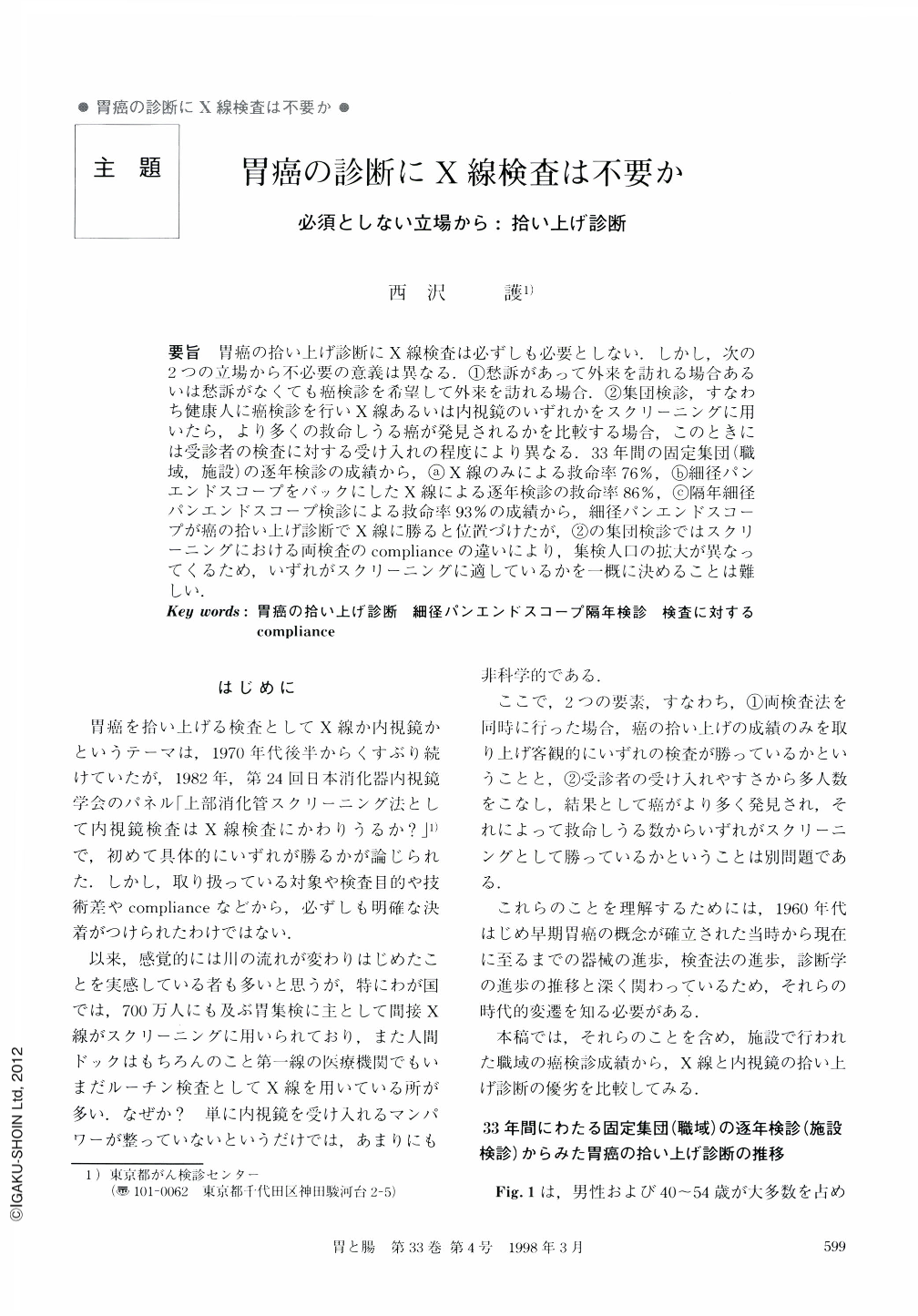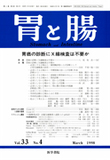Japanese
English
- 有料閲覧
- Abstract 文献概要
- 1ページ目 Look Inside
要旨 胃癌の拾い上げ診断にX線検査は必ずしも必要としない.しかし,次の2つの立場から不必要の意義は異なる.①愁訴があって外来を訪れる場合あるいは愁訴がなくても癌検診を希望して外来を訪れる場合.②集団検診,すなわち健康人に癌検診を行いX線あるいは内視鏡のいずれかをスクリーニングに用いたら,より多くの救命しうる癌が発見されるかを比較する場合,このときには受診者の検査に対する受け入れの程度により異なる.33年間の固定集団(職域,施設)の逐年検診の成績から,(a)X線のみによる救命率76%,(b)細径パンエンドスコープをバックにしたX線による逐年検診の救命率86%,(c)隔年細径パンエンドスコープ検診による救命率93%の成績から,細径パンエンドスコープが癌の拾い上げ診断でX線に勝ると位置づけたが,②の集団検診ではスクリーニングにおける両検査のcomplianceの違いにより,集検人口の拡大が異なってくるため,いずれがスクリーニングに適しているかを一概に決めることは難しい.
It was concluded that for the intial spotting diagnosis of gastric cancer, x-ray examination is not a“sine qua non”. However,“sine qua non”should be understood as limited to the following two cases.
1) In cases where visits to the clinic are made with complaints that need to be further diagnosed, or without complaints but hoping to undergo a cancer detection test.
2) In cases of mass screening of seemingly healthy examinees to detect cancers from the aspect of curability as well as from the aspect of number. The preference of endoscopy by examinees results in x-ray not being used, but this is quite apart from the question of which is more effective x-ray or endoscopy.
Methods: Annual cancer detection had been performed on an ingroup (occupational one) using the following methods on subjects over 33 years. The ingroup 40 to 54 years of age (males by 90%).
a) 1963 to 1969: average number of examinees per year 1,500 Screening, indirect x-ray→Detailed, ordinary x-ray (21% referred after screening).
b) 1970 to 1979: average number of examinees per year 3,000 Screening, remote x-ray TV→Detailed, ordinary x-ray (4% referred after screening).
c) 1980 to 1995: average number of examinees per year 5,000 Panedoscopic examination was recommended but examinees could have their choice between x-ray and panendoscopy, x-ray being performed every year, endoscopy every other year as follows.
c-1) 50% of examinees hoping to undergo x-ray TV Screening, remote x-ray TV (annually)→Detailed, panendoscopy.
c-2) 50% of examinees hoping to undergo panendoscopy Screening, panendoscopy (every other year).
Results: a) Cancers detected 16 (m 5, sm 3, mp 2, s 6): 5 years survival rate 67%. b) Cancers detected 32 (m 5, sm 13, mp 3, ss 3, s 8): 5 year s.r. 76%. c) Cancers detected 107 (m 63, sm 28, mp 4, ss 2, s 10): 5 year s.r. 92%. c-1) early cancer (m+sm): 80% of total cancers, 5 year s.r. about 86%. c-2) early cancer (m+sm): 89% of total cancers, 5 year s.r. about 93%.
Conclusions: Based on the above mentioned results, it can be concluded that panendoscopic examination preferred to be carried out every other year exceeded other possible combinations. Hence, since the compliance or preference of patients for endoscopy during visits to the clinic for the sake of cancer detection is extremely high, x-ray can be ruled out as a“sine qua non”in the initial screening step.

Copyright © 1998, Igaku-Shoin Ltd. All rights reserved.


